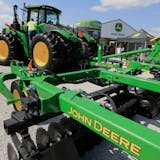As November wanes, so does the white-tailed deer reproductive season. By now, most does have been bred. The bucks are worn down after several weeks of chasing females and battling for propagation rights. The deer are becoming less active.
Granted, there are still spurts of rutting activity. But with the arrival of snow and cold, the bucks have mostly shifted into resting and feeding mode. Likewise, bow and muzzleloader hunters hoping to get that deer in their sights should do a little shifting.
Morning is prime time for hunting during the rut. Not so any longer — deer will be secure in their bedding areas at dawn.
Now is the time to concentrate your efforts on hunting near food sources in the afternoon. Deer will be most active when the temperature is warm — even mature bucks will be out feeding during the warmest hours of the day. The early onset of snow and cold this year probably has accelerated midday feeding activity.
Deer usually won't wander into wide open farm fields, especially after being hunted for the past several weeks. But out-of-the-way feeding spots can be productive. These locations might include remote farm fields, deer food plots, forest clear-cuts where plant regeneration has occurred and wild meadows — especially those containing goldenrod, a favorite late-fall and winter food source for deer. Deer ignore the goldenrod leaves when they're green, but relish the dry brown leaves as soon as they're frozen.
Of course, an oak ridge full of acorns is the ideal spot. But the red oak acorn crop was a near total failure this year, at least here in central Minnesota. Deer are seeking alternative food sources.
I always enjoy wandering the edges of forest clearings and meadows in the late fall, whether I have camera or bow in hand. The snow reveals the comings and goings of deer and other animals, making it a great time to be afield — whether you're perched in a deer stand or quietly stalking the creatures.
It's nearly impossible to sneak up on deer when the snow is frozen and crusty. But if the temperature is below freezing and the snow remains soft and fluffy, it's often possible to approach deer by stalking into or across the wind, and by moving only when deer are engrossed with feeding.



